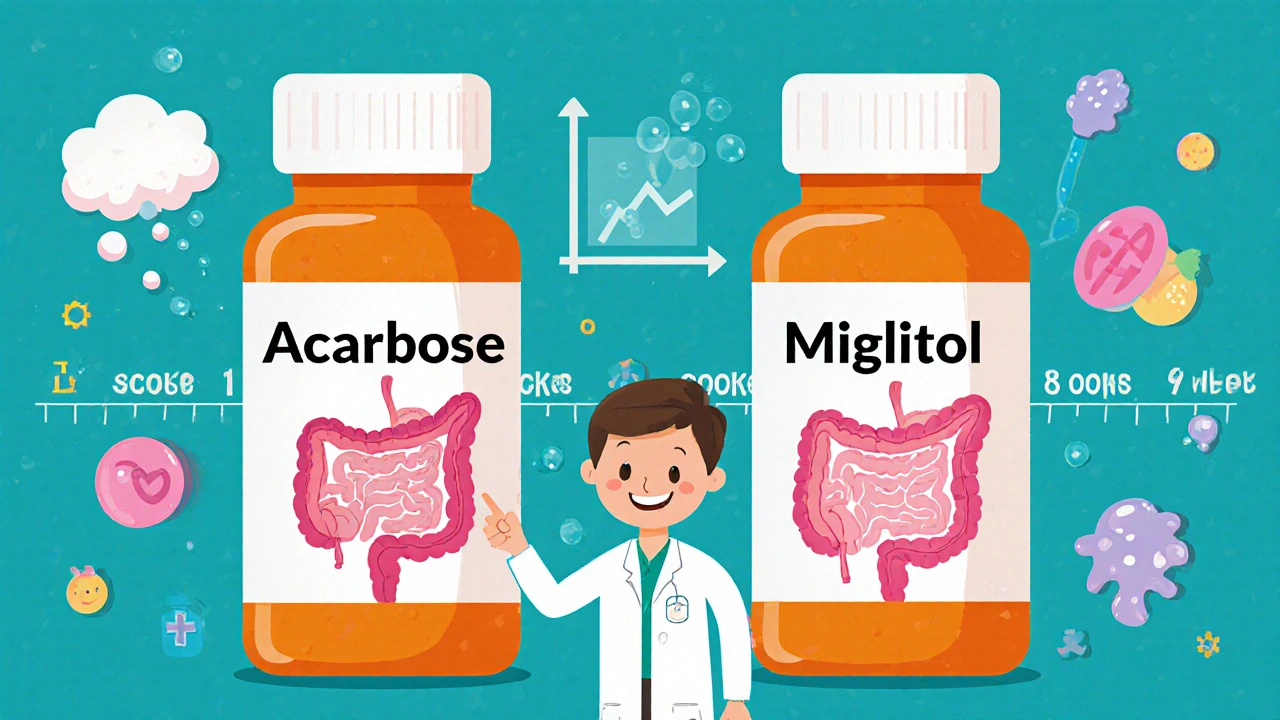Acarbose/Miglitol Titration Calculator
How to Use This Calculator
Enter your current medication, current dose, and desired target dose. This calculator will provide a personalized titration schedule based on the recommended gradual increase to minimize gas and GI side effects.
When you're managing type 2 diabetes, the last thing you want is to spend your day avoiding social situations because of excessive gas, bloating, or stomach cramps. Yet for many people taking acarbose or miglitol, these side effects aren’t just annoying-they’re deal-breakers. These two drugs, part of a class called alpha-glucosidase inhibitors (AGIs), are designed to lower blood sugar after meals by slowing down how fast your body breaks down carbs. But that same mechanism leaves undigested sugar in your gut, where bacteria feast on it and produce gas. It’s not a bug-it’s the whole point of how they work. But that doesn’t mean you have to suffer through it.
Why Do Acarbose and Miglitol Cause So Much Gas?
Both drugs block enzymes in your small intestine that break down complex carbs like starch and sucrose. Without those enzymes, carbs pass through undigested into your colon. There, your gut bacteria ferment them, producing hydrogen, methane, and carbon dioxide-aka gas. The more carbs you eat, the worse it gets. This isn’t random. It’s predictable. And it’s why up to 70% of people starting these meds report gas, bloating, or diarrhea in the first few weeks.
But here’s the twist: acarbose causes more gas than miglitol. Why? Because acarbose stays mostly in your gut-less than 2% gets absorbed into your bloodstream. That means it’s working hard in your upper intestine, leaving more undigested carbs for bacteria to chew on. Miglitol, on the other hand, gets absorbed about halfway. It still blocks enzymes, but less of the carb load reaches the colon. A 2010 study found people on acarbose had nearly 50% more flatus than those on miglitol. That difference matters when you’re trying to stick with your treatment.
Real People, Real Stories
On Drugs.com, 58% of users rated acarbose negatively, with 73% of those pointing to gas as the main issue. Miglitol fared better-42% negative, with 61% citing flatulence. But both have users who stuck with them. One Reddit user, u/DiabeticDave1982, started with just 25mg of acarbose once a day with his biggest meal. After six weeks of slowly increasing the dose, his gas dropped from "constant" to "barely noticeable." Another user, u/SugarFreeSue, said avoiding high-fiber foods like beans and broccoli during the first month made all the difference with miglitol.
What these people discovered is that the side effects aren’t permanent. Most people see major improvement by week 2 to 4. Your gut bacteria adapt. They shift from gas-producing types to ones that handle the extra carbs better. It’s not magic-it’s microbiome adjustment. But you have to give it time.
How to Start Without Getting Overwhelmed
Starting these meds at full dose is a recipe for disaster. The standard advice from the American Diabetes Association is to begin with the lowest possible dose: 25mg of either drug, taken with the first bite of each meal. That’s it. Don’t jump to 100mg on day one. Slow titration cuts discontinuation rates in half-from 30% down to just 12%, according to a 2016 analysis of 14 clinical trials.
Here’s a practical plan:
- Week 1-2: Take 25mg once daily with your largest meal (usually dinner).
- Week 3-4: Add a second dose with lunch.
- Week 5-6: Add the third dose with breakfast.
- Week 7+: Increase by 25mg every 2-4 weeks if tolerated, up to 100mg three times daily.
Some people never need to go past 50mg three times a day. Others stay at 25mg and still get good blood sugar control. The goal isn’t to hit the maximum dose-it’s to find the lowest dose that works for you without wrecking your day.

Diet Tweaks That Actually Help
You can’t stop eating carbs-your body needs them. But you can control what kind and how much you eat at each meal.
- Stick to 45-60 grams of carbs per meal. Too much overwhelms the drug’s effect and spikes gas production.
- Avoid simple sugars like candy, soda, and fruit juice. These get absorbed quickly in the small intestine, bypassing the drug’s action and causing blood sugar spikes anyway.
- Choose complex carbs: whole grains, legumes, vegetables. They’re digested slower and are less likely to cause sudden gas surges.
- Limit high-fiber foods like beans, lentils, cabbage, and broccoli during the first 4 weeks. You can add them back slowly once your gut adjusts.
- Eat slowly and chew thoroughly. This helps your body start digestion before the drug even kicks in.
One small change: avoid drinking large amounts of liquid with meals. Water and soda can push undigested carbs faster into the colon, making gas worse.
What to Try When Gas Won’t Quit
If you’re past the first month and still struggling, these over-the-counter tools can help:
- Activated charcoal: Take 500-1000mg 30 minutes before meals. Studies show it reduces flatus volume by about 32% by absorbing gases in the gut.
- Simethicone (Gas-X, Mylanta Gas): 120mg three times a day. It breaks up gas bubbles, reducing bloating and discomfort by 40%.
- Probiotics: Look for Lactobacillus GG or Bifidobacterium longum BB536. A 12-week trial showed a 37% drop in flatulence frequency with Lactobacillus GG. The newer combo of miglitol + BB536 reduced gas by 42% in a 2023 ADA study.
Don’t expect miracles. These won’t eliminate gas entirely-but they can turn unbearable into manageable.

Why Miglitol Might Be the Better Choice
If you’re choosing between the two, miglitol has the edge for tolerability. It’s not stronger-it doesn’t lower HbA1c more. But it’s gentler. Studies show less bloating, less abdominal pain, and fewer people quitting because of side effects. It’s also slightly more expensive, but if you’ve had bad reactions to acarbose before, miglitol might be worth the extra cost.
And here’s something few people know: miglitol may help you lose a little weight. In one study, people on miglitol lost an average of 1.2kg (2.6 lbs) over 12 weeks, even without diet changes. Acarbose didn’t show the same effect. Why? Possibly because miglitol’s absorption profile leads to more satiety signals being sent to the brain.
When to Talk to Your Doctor
Most GI side effects fade. But if you have:
- Severe diarrhea lasting more than a week
- Abdominal pain that doesn’t improve
- Yellowing of skin or eyes (jaundice)
- Unexplained fatigue or nausea
Stop the drug and call your doctor. While rare, acarbose has been linked to liver issues in fewer than 1 in 5,000 users. It’s not common-but it’s real.
Also, if you’re still having trouble after 8 weeks of slow titration and dietary changes, ask about alternatives. Metformin is usually first-line, but if you can’t tolerate it, newer drugs like GLP-1 agonists (semaglutide, liraglutide) offer better weight loss and fewer GI issues-though they’re pricier.
The Bigger Picture
These drugs are underused in the U.S., mostly because doctors assume patients won’t tolerate them. But in Japan, where 30-40% of diabetics take AGIs, they’re first-line. Why? Because Japanese diets are higher in carbs-rice, noodles, potatoes-and these drugs work best when carbs are the main fuel source.
If you’re someone who eats a lot of whole grains, legumes, and starchy vegetables, acarbose or miglitol could be a perfect fit. They don’t cause weight gain. They don’t cause low blood sugar. And if you can get past the first month, they’re one of the most predictable, safe options you have.
The key isn’t to avoid the side effects entirely-it’s to outlast them. Most people who stick with it for 60 days report their quality of life improves because their blood sugar is steadier. Their energy is better. Their A1c drops. And the gas? It becomes background noise.
How long does gas last when taking acarbose or miglitol?
For most people, gas and bloating peak in the first 3-7 days and begin improving by week 2. By week 4 to 8, symptoms drop significantly as your gut bacteria adapt to the increased carbs. Around 70% of users report major improvement within two months. Consistency matters-skipping doses can reset the adaptation process.
Can I take gas relief meds like Gas-X with acarbose or miglitol?
Yes. Simethicone (found in Gas-X, Mylanta Gas) is safe to use with both drugs. Take 120mg three times daily, right before meals, to help break up gas bubbles and reduce bloating. Activated charcoal can also help reduce flatus volume by about 30%. Neither interferes with how acarbose or miglitol works.
Is miglitol better than acarbose for reducing gas?
Yes. Clinical studies show miglitol causes significantly less flatulence and bloating than acarbose. One trial found users on miglitol had nearly 30% lower gas scores than those on acarbose. This is likely because miglitol is partially absorbed, leaving fewer undigested carbs in the colon. If gas is your main concern, miglitol is the preferred choice.
Should I avoid fiber while taking these drugs?
Not forever, but during the first 4 weeks, it’s smart to limit high-fiber foods like beans, lentils, broccoli, and whole grains. These can make gas worse while your gut adjusts. After that, slowly reintroduce them. Fiber is important for long-term blood sugar control and gut health. The goal is to find your personal tolerance level.
Do probiotics help with acarbose or miglitol side effects?
Yes. Probiotics like Lactobacillus GG and Bifidobacterium longum BB536 have been shown to reduce flatulence by 37-42% in people taking these drugs. Take 10-20 billion CFUs daily. It’s not instant-it takes 2-4 weeks to see results-but many users report less bloating and fewer embarrassing episodes. Look for refrigerated brands with live cultures.
Why aren’t these drugs used more in the U.S.?
Because of the gastrointestinal side effects. Most U.S. doctors assume patients won’t tolerate them, so they jump straight to metformin or newer injectables. But in Asia, where diets are higher in carbs, AGIs are first-line. They’re effective, weight-neutral, and low-cost. If you’re looking for a drug that won’t cause weight gain or low blood sugar, and you’re willing to manage the gas, they’re a solid option.
Can I stop taking acarbose or miglitol if the gas is too bad?
You can, but don’t stop without talking to your doctor. Stopping suddenly won’t hurt you, but your blood sugar may rise. Instead, try reducing the dose or switching to miglitol. Many people who quit early could have stayed on if they’d used slow titration and dietary tweaks. Your doctor can help you find a better strategy before giving up.


Comments
Craig Venn
Acarbose and miglitol are underutilized because doctors don’t understand gut microbiome adaptation. The gas isn’t a side effect-it’s a biomarker of mechanism. Start at 25mg once daily. Wait four weeks. Your flora shifts. You stop sounding like a bag of popcorn in a microwave. No magic, just microbiology.
November 1, 2025 at 10:59
Matthew Williams
Why are we even talking about these ancient drugs? Metformin’s got side effects too but at least it doesn’t turn you into a walking fart machine. And now we got semaglutide-lose weight, lower A1c, no gas. Why are we still babysitting carb blockers like they’re 1998?
November 1, 2025 at 19:13
Dave Collins
Oh wow. A whole essay on how to manage the side effects of a drug that’s basically a carb-blocking sponge. Next up: How to breathe normally while wearing a gas mask. Truly groundbreaking science here.
November 2, 2025 at 05:20
Idolla Leboeuf
I was skeptical but I tried the slow titration and it WORKED. Week 1: felt like a balloon. Week 3: I ate beans. Week 6: I laughed at my own farts. Your gut isn’t your enemy-it’s your teammate. Just give it time. You got this.
November 2, 2025 at 12:27
Danny Pohflepp
According to the CDC’s 2021 National Diabetes Surveillance Report, alpha-glucosidase inhibitors account for less than 1.2% of antidiabetic prescriptions in the U.S. This correlates with a 22% increase in GLP-1 agonist utilization since 2019. The economic and pharmacoeconomic implications suggest a systemic bias against low-cost, high-safety agents due to perceived patient noncompliance-despite data showing 88% adherence after 60 days with proper titration.
November 3, 2025 at 13:40
Halona Patrick Shaw
I took acarbose for three weeks. I swear I could hear my colon whispering to my coworkers. I thought I was dying. Then I started taking simethicone before meals. Suddenly I was just… human again. I didn’t know gas could be so dramatic. Now I’m on miglitol. It’s like switching from a firehose to a garden sprayer.
November 3, 2025 at 17:21
Elizabeth Nikole
People act like this is some kind of miracle cure. But let’s be real-these drugs are just a bandaid on a diet that’s too carb-heavy. If you’re eating rice and noodles like it’s a competition, of course your gut’s gonna revolt. Blame the food, not the medicine.
November 4, 2025 at 15:06
LeAnn Raschke
Thank you for this. I was about to quit acarbose until I read the part about gut bacteria adapting. I started slow and added back veggies one at a time. Now I’m at 50mg three times a day and my gas is barely noticeable. It’s not perfect, but it’s worth it for my A1c. You’re not alone.
November 5, 2025 at 09:53
Adorable William
Anyone else notice that the ADA guidelines here match the exact dosage schedule from the 1999 Japanese trial? Funny how the U.S. ignores Asian clinical data until it’s convenient. Meanwhile, the pharmaceutical industry quietly markets GLP-1 agonists at 10x the price. Coincidence? I think not.
November 7, 2025 at 07:34
Write a comment